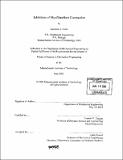Inhibition of myofibroblast contraction
Author(s)
Corin, Karolina A. (Karolina Ann), 1981-
DownloadFull printable version (4.689Mb)
Other Contributors
Massachusetts Institute of Technology. Dept. of Mechanical Engineering.
Advisor
Ioannis V. Yannas.
Terms of use
Metadata
Show full item recordAbstract
Although current medical procedures cannot restore complete function of a transected nerve, inserting both of its ends in a tube helps it regenerate. The regenerate is inferior to the uninjured nerve: it has a smaller diameter and poorer electrical conduction. Layers of contractile cells known as myofibroblasts have been observed around regenerated nerve portions. An inverse relationship between the layer thickness and the quality of the regenerate has also been observed. These findings suggest that the cells are exerting contractile forces which prevent the regenerating nerve from fully developing. Inhibiting this contraction should thus improve the quality of nerve regeneration. Alpha smooth muscle actin ([alpha]-SMA) is a critical contractile protein. Its expression can be upregulated by the growth factor TGF-[beta]1, and blocked by the pharmacological agent PP2. To investigate whether blocking SMA expression alone can inhibit myofibroblast contraction, NR6 wild type fibroblasts were seeded into short cylindrical collagen-GAG matrices, and administered either media alone, media with TGF-[beta]1 (3ng/ml), or media with TGF-[beta]1 and PP2 (10 [mu]M). Non-seeded matrix samples were also prepared. The matrix diameters were measured every day for 12 days, after which the matrices were digested and the number of adhered cells were counted. The daily change in matrix diameter was calculated. The results showed that the cells contracted the matrices. TGF-[beta]1 increased cell contractility, while PP2 inhibited it.. (cont.) Normalizing the Day 12 diameter change measurements to cell number and the original matrix diameter showed that TGF-[beta] increased the strain generated by each cell ... relative to ... for untreated cells), and that PP2 counteracted this effect (...). Using the linear elastic constitutive relations, the average force exerted per cell was calculated for the untreated cells (...), TGF-[beta]1 stimulated cells (...), and TGF-[beta] + PP2 stimulated cells (...). The cell counts after Day 12 indicate that PP2 interferes with cell adhesion to the matrices. After 6 hours in culture, 21% of untreated cells, 25% percent of cells treated with TGF-[beta] 1, and 25% of cells treated with TGF-[beta]1 and PP2 had adhered. By Day 12, only 12% of the seeded untreated cells, 14% of cells treated with TGF-[beta] I, and 3.2% of cells treated with both TGF-[beta]1 and PP2 remained adhered. This study thus indicates that PP2 inhibits cellular contraction, possibly by preventing cell-substrate adhesion
Description
Thesis (S.M.)--Massachusetts Institute of Technology, Dept. of Mechanical Engineering, 2005. Includes bibliographical references (p. 46-49).
Date issued
2005Department
Massachusetts Institute of Technology. Department of Mechanical EngineeringPublisher
Massachusetts Institute of Technology
Keywords
Mechanical Engineering.